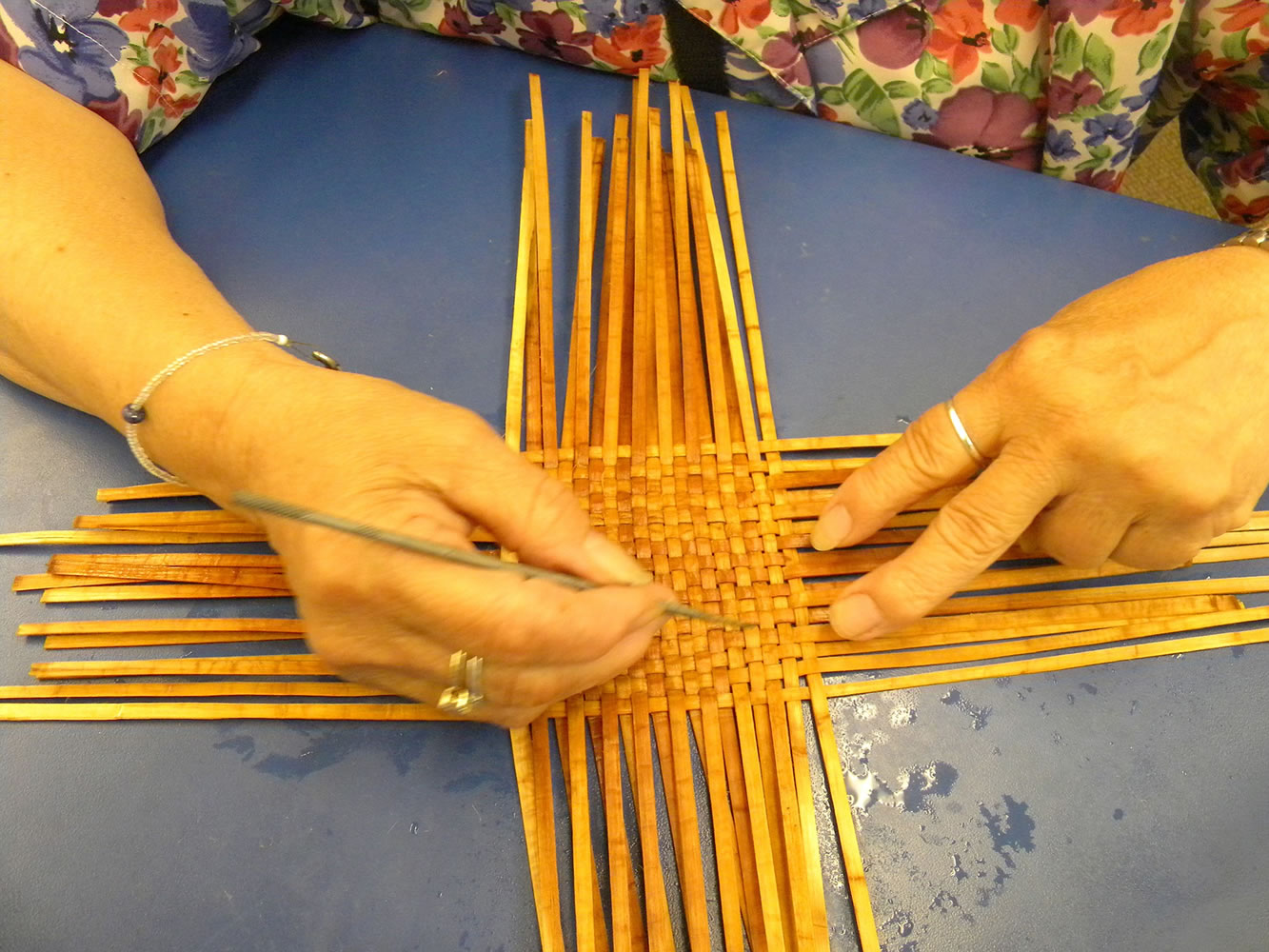If you go
• What: Traditional Technology Weekend.
• When: Noon-4 p.m. Saturday and Sunday.
• Where: Cathlapotle Plankhouse, Ridgefield National Wildlife Refuge Carty Unit.
• Admission: $3 parking fee per vehicle.
• Contact: 360-887-4106 or visit ridgefieldfriends.org.
Alta High Elk’s fingers deftly wove thin cedar strips. Eventually, her work will yield a small cedar basket. Seated next to her, Caroline Underwood twisted a Western red cedar cordage handle for her cedar huckleberry basket.
Beejee Barton carved a ceremonial dance paddle.
“Everything in carving I learned from Greg (Robinson),” Barton said, holding up a rattle on which she had carved a Chinookan face.
Native American artists Greg Robinson, Chinook Nation, and Greg Archuleta, Confederated Tribes of Grande Ronde, offer advice to the student artists at the Grande Ronde Tribal Center in Southwest Portland. Robinson is teaching carving; Archuleta is helping with basketry.
If you go
• What: Traditional Technology Weekend.
• When: Noon-4 p.m. Saturday and Sunday.
• Where: Cathlapotle Plankhouse, Ridgefield National Wildlife Refuge Carty Unit.
• Admission: $3 parking fee per vehicle.
• Contact: 360-887-4106 or visit ridgefieldfriends.org.
Robinson and Archuleta will bring their artwork to Cathlapotle Plankhouse at the Ridgefield National Wildlife Refuge this weekend. Robinson’s son, Justin Robinson, will teach a Chinook language lesson. On Sunday additional demonstrations will be offered in atlatl throwing, archery and flintknapping, or making arrowheads.
When the full-scale traditional plankhouse was built in 2008, Robinson was the acting construction manager and tribal liaison. The plankhouse stands at the archaeological site of Cathlapotle, a settlement of the Chinookan people. Robinson was born in Ridgefield and lives in Vancouver.
Robinson and Archuleta travel throughout the Willamette Valley teaching traditional arts to tribal members.
“We teach a series of classes for the Grande Ronde tribe because they have Chinookan bands of Indian nations,” Robinson said. “It’s important to train other Chinook carvers,” Robinson said.
Inspired by stories
Seated at a table in the Grande Ronde classroom, Robinson used a sharp tool to carve a section of cedar, which eventually will become a handle for a carving tool. After taking some basic carving classes, Robinson said he has been carving seriously for about 10 years.
Most of Robinson’s designs are inspired by Chinook stories handed down from generation to generation. One of the pieces he was working on is a red cedar bowl featuring Sisiutl, a double-headed serpent.
Robinson’s red and yellow cedar panel “Frog and Moon” depicts frog in red cedar and also in semi-human form holding a representation of the moon. His carving is based on this Chinook story:
“Frog hoarded the moon inside its mouth. The nights were pitch black without the moon and people misbehaved, knowing they could not be seen. Frog would pull the moon out and embarrass the people much to his amusement.”
Robinson’s “Frog and Moon” piece was purchased for a private collection in the U.K. The Portland Art Museum has purchased a couple of his carvings for its permanent collection. His work is available at Quintana Galleries in Portland and Steinbrueck Native Gallery in Seattle.
Pigments in nature
Basket maker Archuleta said he and other artists go on gathering excursions to find basketry materials.
“We go all over Washington and Oregon gathering bark and other weaving material,” Archuleta said.
While gathering materials, they sometimes find rocks in vibrant shades of verdigris, vermillion and ochre, Archuleta said. Just as his ancestors did, he uses a mortar and pestle to grind the rocks into a fine powder to create natural pigments. When he is ready to paint, Archuleta says he adds chicken eggs to bind the pigments and create tempera. His ancestors sometimes added salmon eggs, he said. Water does not work.
Children visiting Cathlapotle Plankhouse on Saturday and Sunday may have an opportunity to use a mortar and pestle to grind pigments.
As the artists in the classroom worked, they talked about gathering expeditions, including gathering camas, an onionlike bulb that was a staple in the traditional Native American diet. Camas, which grows abundantly in Clark County, is high in protein, with 5.4 ounces of protein in a pound of roots. In comparison, steelhead trout has 3.4 ounces of protein per pound. Traditionally, camas bulbs were roasted in a fire pit lined with heated flat stones for many hours and sometimes days.
Barton said she had recently gathered and roasted camas.
As she continued carving, Barton nodded toward and kitchen and said, “Stew with camas is in the crockpot.”




